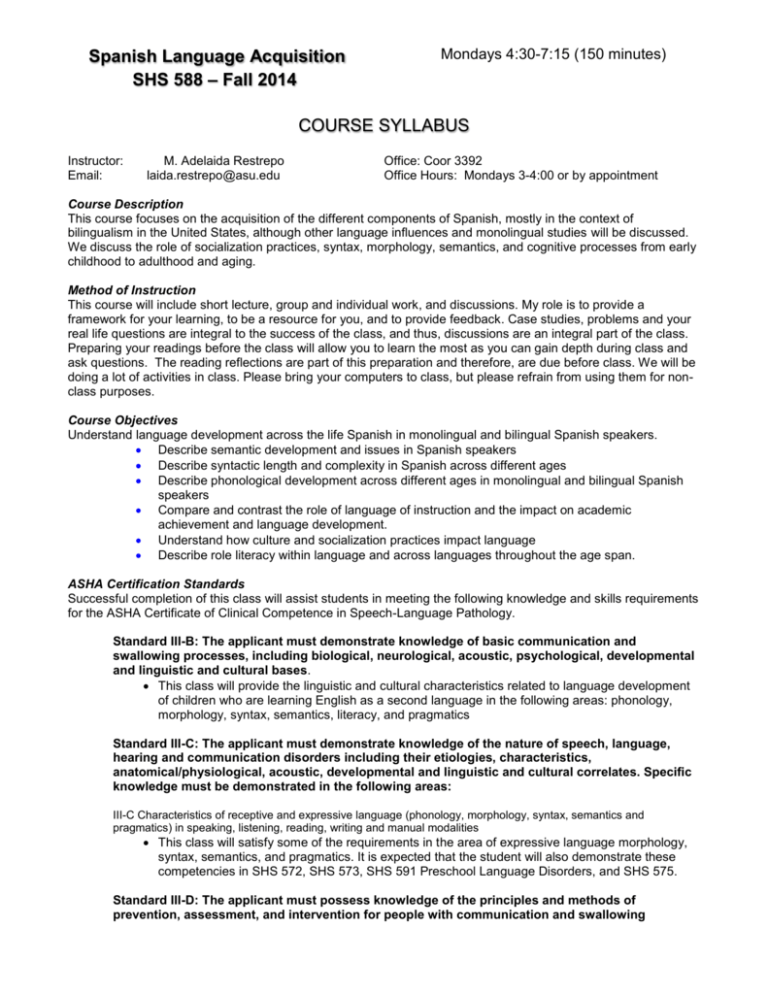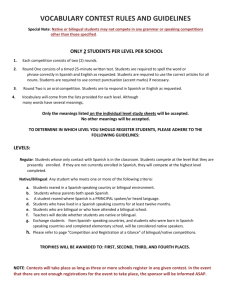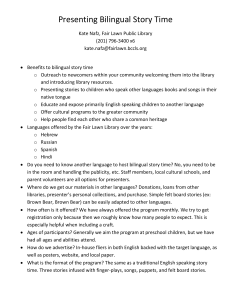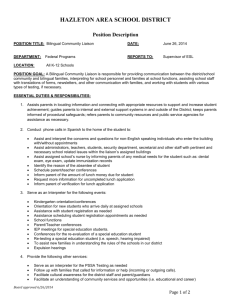588 Syllabus Fall 2014 - Bilingual Language and Literacy Lab
advertisement

Spanish Language Acquisition SHS 588 – Fall 2014 Mondays 4:30-7:15 (150 minutes) COURSE SYLLABUS Instructor: Email: M. Adelaida Restrepo laida.restrepo@asu.edu Office: Coor 3392 Office Hours: Mondays 3-4:00 or by appointment Course Description This course focuses on the acquisition of the different components of Spanish, mostly in the context of bilingualism in the United States, although other language influences and monolingual studies will be discussed. We discuss the role of socialization practices, syntax, morphology, semantics, and cognitive processes from early childhood to adulthood and aging. Method of Instruction This course will include short lecture, group and individual work, and discussions. My role is to provide a framework for your learning, to be a resource for you, and to provide feedback. Case studies, problems and your real life questions are integral to the success of the class, and thus, discussions are an integral part of the class. Preparing your readings before the class will allow you to learn the most as you can gain depth during class and ask questions. The reading reflections are part of this preparation and therefore, are due before class. We will be doing a lot of activities in class. Please bring your computers to class, but please refrain from using them for nonclass purposes. Course Objectives Understand language development across the life Spanish in monolingual and bilingual Spanish speakers. Describe semantic development and issues in Spanish speakers Describe syntactic length and complexity in Spanish across different ages Describe phonological development across different ages in monolingual and bilingual Spanish speakers Compare and contrast the role of language of instruction and the impact on academic achievement and language development. Understand how culture and socialization practices impact language Describe role literacy within language and across languages throughout the age span. ASHA Certification Standards Successful completion of this class will assist students in meeting the following knowledge and skills requirements for the ASHA Certificate of Clinical Competence in Speech-Language Pathology. Standard III-B: The applicant must demonstrate knowledge of basic communication and swallowing processes, including biological, neurological, acoustic, psychological, developmental and linguistic and cultural bases. This class will provide the linguistic and cultural characteristics related to language development of children who are learning English as a second language in the following areas: phonology, morphology, syntax, semantics, literacy, and pragmatics Standard III-C: The applicant must demonstrate knowledge of the nature of speech, language, hearing and communication disorders including their etiologies, characteristics, anatomical/physiological, acoustic, developmental and linguistic and cultural correlates. Specific knowledge must be demonstrated in the following areas: III-C Characteristics of receptive and expressive language (phonology, morphology, syntax, semantics and pragmatics) in speaking, listening, reading, writing and manual modalities This class will satisfy some of the requirements in the area of expressive language morphology, syntax, semantics, and pragmatics. It is expected that the student will also demonstrate these competencies in SHS 572, SHS 573, SHS 591 Preschool Language Disorders, and SHS 575. Standard III-D: The applicant must possess knowledge of the principles and methods of prevention, assessment, and intervention for people with communication and swallowing disorders, including consideration of anatomical/physiological, psychological, developmental, and linguistic and cultural correlates of the disorders. III-D. Assessment of receptive and expressive Language This class will satisfy some of the requirements in the area of expressive language morphology , syntax, semantics, and pragmatics. It is expected that the student will also demonstrate these competencies in SHS 572, SHS 573, SHS 591 Preschool Language Disorders, and SHS 575. Blackboard - Emails Blackboard is software designed to organize course information and to store course content so that it may be accessed via the Internet. To use blackboard you must have an ASU User ID. By enrolling in the course you are automatically entered into the Blackboard database. To access Blackboard go to http://my.asu.edu/. Information for this course and the points you earn will be posted to Blackboard. Please check Blackboard several times during the week for new information. I’ll be also emailing you frequently with updates and comments. Textbooks & Resources Goldstein, B. (Editor) (2012) Bilingual language development and disorders in Spanish-English speakers. Brooks Publishing. Altarriba, A. & Heredia, R. R. (2011). An introduction to bilingualism: Principles and Processes. Pyschology Press. New York. Centeno, J. & Anderson, R. (2010*). Additional readings will be available in blackboard. We may find additional readings that become available throughout the semester that are of interest to us. So this list is not final, we may add, delete or replace readings. Course Responsibilities & Requirements The Arizona Board of Regents requires a minimum of 45 hours of work by each student for each unit of credit. At least 45 contact hours of lecture, discussion, or evaluation as well as a minimum of 30 hours of student homework is required for each unit of credit. This means that for this 3-unit class you should expect an average of 6 hours of homework per week. The amount will vary according to topic and assignments. Please plan to: Attend classes Complete assigned readings as indicated in the syllabus. Complete case studies Class Notes Notes will be posted on Blackboard right before class expecting them in the morning or the day before is unrealistic. These are intended to help you follow instruction, but they do not provide all important class content, depth or integration of information. Additional information based on discussions and comments is part of the class material. Special Needs I am happy to make the necessary accommodations for you to have full access to the class due to a temporary or permanent disability. Students with disabilities must make an appointment with me to discuss their particular needs during the first week of class and must be registered with the ASU office of Disability Resources for Students. Requests for accommodations for disability need to be processed by the Disability Resources for Students department (DRS). And accommodation for long-term medical problems should be processed by the College of Health Solutions. Course Evaluation Please feel free to give me your constructive comments about class via email, office visits, or anonymously via a note in my mailbox in the copy room at any time during the semester. You will also have the opportunity to formally evaluate the class at the end of the semester through online methods. Code of Conduct By enrolling in or auditing this course you agree to be familiar with and abide by the ASU Student Code of Conduct. Excerpts from this code are part of the syllabus. You should be familiar with the entire code found at the web address provided. The code of conduct applies to ALL aspects of this course throughout the semester. You should review the code and this syllabus on a regular basis. http://students.asu.edu/srr/code For purposes of this class, even when you have worked on a project with others, the written work you turn in must be written independently. Do not copy the work of others or allow your work to be copied. Guard against plagiarism in all of your work. When in doubt, please ask me how to reference materials correctly. Do not copy and paste from other sources even if you change a few words; that is still considered plagiarism. Please submit your papers through safe assignment. Please note that this catches cut and paste from different articles and your own previous work. For the exam collaboration is absolutely not allowed. All forms of student academic dishonesty, including but not limited to, cheating, fabrication, facilitating academic dishonesty and plagiarism are not allowed. For a full description please go to the following web site: http://www.asu.edu/aad/manuals/sta/sta104-01.html. If you are found to have violated the student conduct, I will give you a grade 0 for your assignment. If you do it twice, it will be an automatic F for the class. If you plagiarize /collaborate or cheat in the final exam, you will fail it. In case of emergency Please remain clam. Leave the building as soon as possible, unless instructed otherwise. In any case, please listen carefully for instruction on how to proceed from your instructor or authorized personnel. Coursework and Points Awarded Readings Reflections and Questions Each week you respond to a question about the readings. The purpose is to prepare you for class and integrate the readings. Grading: 15 points each x 8 = 120 Please keep them at 1 single-spaced page. Please submit through safe assignment. Due at 4 pm the day of class. Late reflections will not be accepted. Labs (electronic copies) You will be given 4 labs to practice different analyses: syntactic length and complexity, phonological analyses, grammatical development, and narrative development. Labs will be home assignments, which then will be discussed in class. You may work in pairs or individually, in terms of problem solving, but please write your labs individually. Grading: 20 points each lab x 4 = 80 Each case will have different grading criteria. Refer to each specific case. However, organization, grammar, and clarity are always part of the grade. In addition, integration of readings is critical to the grader. Please show all your work clearly so that I can assess your work accurately and give you appropriate feedback (worth of up to 5 points). Due dates: see class schedule. Final exam You will have a final exam at the end of the semester that will involve short and long essay questions. They may also involve some analyses. The specific format and medium will be determined closer to the exam date. The exam is worth 200 points. SUMMARY OF COURSEWORK AND POINTS AWARDED Semester Grades Your final grade will be based upon accumulated points earned as follows: Task Points 4 @ 20 points Labs each Reading reflections 8 @ 15 points Final Exam 100 points TOTAL *There is not an option for extra credit Total 80 120 200 400 A+ AB+ BC+ CD+ D- 100-96% 95-90 89-85 84-80 79-75 74-70 69-65 64-60 Week/ Date Topic Main Points Assignments and Preparation for Class Anderson & Centeno – Chapter 1; 1 8/ 25 Course introduction Spanish-English contrastive analysis 9/1 2 9/8 Labor Day Phonological development 3 9/15 Context of Spanish speakers in the US and Socializations practices 4 9/22 Lexical and semantic development 5 9/29 6 10/6 Morphological development – Lulu Martinez Syntactic NO CLASS Goldstein – Ch. 15 Fabiano & Goldstein (2010) AJSLP Reading reflection 1: Describe what the similarities and differences are in phonological development between Spanish and English, and between Spanish monolinguals and bilinguals. Goldstein (2012) - Chapters 1, 2 A & H chapter 9*, 10 Reading reflection 2: identify the external factors that impact language development in Latino, bilingual children in the US: familial, cultural, social, and linguistic Goldstein – Ch. 6 & 7; Reading reflection 3 a. Describe what factors influence lexical acquisition in infants and school age children in Spanish and English in a bilingual context; b. are there differences in lexical acquisition between Spanish and English between 1 and 3 years of age? Goldstein – Ch. 8, 9 & 10; Reading Reflection 4 a.What are the differences in morphological acquisition of verbs between Spanish and English; b. what are some bilingual effects on morphological development. Restrepo et al (2010) LSHSS In class activity 1. Develop the vowel and consonant chart for Spanish and contrast it with English 2. Translation from Spanish to English and from English to Spanish a. identify syntactic characteristics the differentiate Spanish and English b. Identify phonotactic and prosodic characteristics that differentiate each language Grading Lab 1 - Finalize the consonant and vowel chart for Spanish Describe what sounds differ from English in in what aspects Develop a developmental chart for sounds and phonological processes for Spanish-speaking children who are monolingual and bilingual using the articles on blackboard Lab 1 due Reading reflection 1 due Discussion and exercise: what aspects characterize your own culture? Research one Latino culture and identify some of the socialization practices that may impact language development Reflection 2 Developmental chart for vocabulary Calculate conceptual vocabulary Reflection 3 due Developmental chart for morphological acquisition Discussion on pronouns – identify, differentiate, and determine the importance on language development and loss What is the difference between language loss and incomplete acquisition? Practice T-unit analysis Practice subordination index Lab 2 assigned Reflection 4 due Lab 2 due Complete a development 10/13 7 10/20 8 10/27 Fall Break - No CLASS Narrative and cohesion development Goldstein – Ch. 12; Reflection 5 Describe differences in narrative structure and discourse between some Latino cultures and English-speaking cultures in the US Literacy development – Carol Mesa 9 11/3 Bilingual Education 10 11/10 Language processing 11 11/17 The bilingual brain – Beatriz Barragan 12 11/24 Bilingual aging 13 12/1 12/8 developmental chart of morphological and syntactic forms for preschool and early school age in Spanish Second language acquisition and language proficiency Practice Cohesion analyses Reflection 5 due TBD Lab 3 assigned Compare two samples in terms of narrative development, syntax and cohesion Reflection 6 due Goldstein Ch. 13, Gorman & Gillam, 2003; Lesaux and Kieffer (2010) Goldstein Ch. 14, 18 Paradis et al Ch. 8 Reflection 6. What are some of the arguments for Teaching in only English? Describe any counter evidence for the English-only movement. Goldstein – Ch. 3 and 5 ; A. & H Chap 3 Reflection 7 – how do sequential and simultaneous bilingual adults differ in language processing? Is there an age factor in general and age of acquisition factor? Describe it. A & H Chapter 6. Gomez- Ruiz (2010); Abutaleby (2009); Schwaeizer et al(2011 ) A & H Chapter 5 Reflection 8 – What are the protective factors in being bilingual and aging? What are the differences in cognitive factors and language processing related to aging between monolinguals and bilingual? Paradis Ch. 5 and 6, Smyk et al (2013). Exam due - INDIVIDUAL WORK – turn in safe assignment Debate English-only vs. Bilingual Education Research what the English-only law is in AZ and what are the AZ DOE current implementation practices for this law? Discussion on the differences in processing between bilingual children and adults Lab 3 due Diagram Reflection 7 due Reflection 8 due Analyze language samples to identify language proficiency levels and stages Lab 4 assigned and due in class Final exam due Arizona Board of Regents Policy Manual - University Policy Excerpts from 5-308 Student Code of Conduct Definitions “Cheating” means intentionally using or attempting to use unauthorized materials, information or study aids. “Fabrication” means intentional falsification or invention of any information or citation. “Plagiarism” means intentionally or knowingly representing the words or ideas of another as one’s own. The following misconduct is subject to disciplinary action: 1. All forms of student academic dishonesty, including cheating, fabrication, facilitating academic dishonesty and plagiarism. Any attempt to commit an act of misconduct prohibited by these rules shall be subject to sanctions to the same extent as completed acts. One or more of the following sanctions may be imposed for any violation of this Code: 1. Expulsion: Permanent separation of the student from the university. An indication of expulsion may appear on the student’s transcript. The expelled student shall not participate in any university-sponsored activity and shall be barred from university property. 2. Suspension: Temporary separation of the student from the university for a specified period of time and/or until specific conditions, if imposed, have been met. An indication of suspension may appear on the student’s transcript. Except where prior approval has been granted by the Dean of Students, a suspended student shall not participate in any university-sponsored activity and shall be barred from the university campus. 3. Probation: Removal of the student from good disciplinary standing. Additional restrictions or conditions may also be imposed. Appropriate university officials shall be notified of the imposition of such sanctions. Probation shall last for a stated period of time and until specific conditions, if imposed, have been met. Any violation of these rules, the conditions of probation or other university rules committed during the probationary period will subject the student to further discipline, including suspension or expulsion. 4. Warning: A written statement advising the student that a violation of this Code has been committed and that further misconduct may result in more severe disciplinary action. 5. Administrative Hold: A status documented in the registrar’s official file which precludes the student from registering until clearance has been received from the Dean of Students in accordance with university rules. 6. Other sanctions permissible under existing university rules. By enrolling in this course you agree to follow the ASU Student Code of Conduct and are subject to sanctions for violations of this code. This code is applicable to all aspects of this course throughout the semester.








